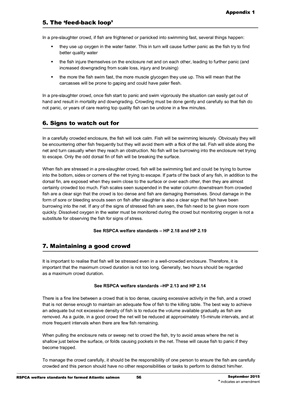
Appendix 1
RSPCA welfare standards for farmed Atlantic salmon 56 September 2015
* indicates an amendment
5. The 'feed-back loop'
In a pre-slaughter crowd, if fish are frightened or panicked into swimming fast, several things happen:
they use up oxygen in the water faster. This in turn will cause further panic as the fish try to find
better quality water
the fish injure themselves on the enclosure net and on each other, leading to further panic (and
increased downgrading from scale loss, injury and bruising)
the more the fish swim fast, the more muscle glycogen they use up. This will mean that the
carcasses will be prone to gaping and could have paler flesh.
In a pre-slaughter crowd, once fish start to panic and swim vigorously the situation can easily get out of
hand and result in mortality and downgrading. Crowding must be done gently and carefully so that fish do
not panic, or years of care rearing top quality fish can be undone in a few minutes.
6. Signs to watch out for
In a carefully crowded enclosure, the fish will look calm. Fish will be swimming leisurely. Obviously they will
be encountering other fish frequently but they will avoid them with a flick of the tail. Fish will slide along the
net and turn casually when they reach an obstruction. No fish will be burrowing into the enclosure net trying
to escape. Only the odd dorsal fin of fish will be breaking the surface.
When fish are stressed in a pre-slaughter crowd, fish will be swimming fast and could be trying to burrow
into the bottom, sides or corners of the net trying to escape. If parts of the back of any fish, in addition to the
dorsal fin, are exposed when they swim close to the surface or over each other, then they are almost
certainly crowded too much. Fish scales seen suspended in the water column downstream from crowded
fish are a clear sign that the crowd is too dense and fish are damaging themselves. Snout damage in the
form of sore or bleeding snouts seen on fish after slaughter is also a clear sign that fish have been
burrowing into the net. If any of the signs of stressed fish are seen, the fish need to be given more room
quickly. Dissolved oxygen in the water must be monitored during the crowd but monitoring oxygen is not a
substitute for observing the fish for signs of stress.
See RSPCA welfare standards - HP 2.18 and HP 2.19
7. Maintaining a good crowd
It is important to realise that fish will be stressed even in a well-crowded enclosure. Therefore, it is
important that the maximum crowd duration is not too long. Generally, two hours should be regarded
as a maximum crowd duration.
See RSPCA welfare standards -HP 2.13 and HP 2.14
There is a fine line between a crowd that is too dense, causing excessive activity in the fish, and a crowd
that is not dense enough to maintain an adequate flow of fish to the killing table. The best way to achieve
an adequate but not excessive density of fish is to reduce the volume available gradually as fish are
removed. As a guide, in a good crowd the net will be reduced at approximately 15-minute intervals, and at
more frequent intervals when there are few fish remaining.
When pulling the enclosure nets or sweep net to crowd the fish, try to avoid areas where the net is
shallow just below the surface, or folds causing pockets in the net. These will cause fish to panic if they
become trapped.
To manage the crowd carefully, it should be the responsibility of one person to ensure the fish are carefully
crowded and this person should have no other responsibilities or tasks to perform to distract him/her.